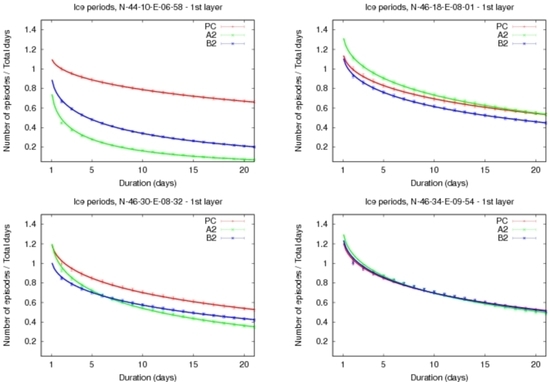The Occurrence of Cold Spells in the Alps Related to ClimateChange
Abstract
:1. Introduction
2. Models Involved in the Study
2.1. RegCM3
2.2. UTOPIA
3. Work Description
4. Results and Discussion
4.1. Categorisation of the Trends in Cold Breaks Frequency versus Their Length
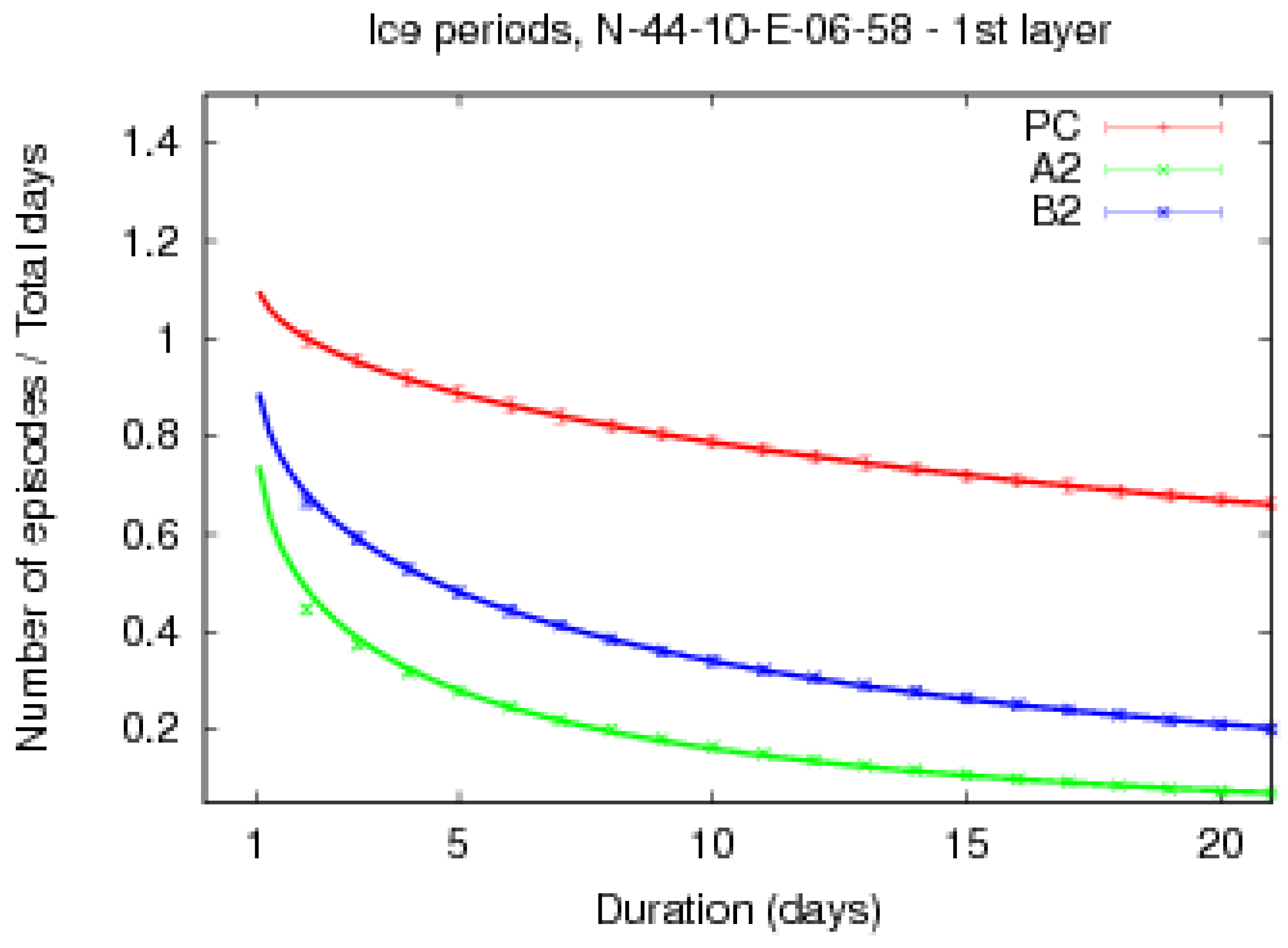
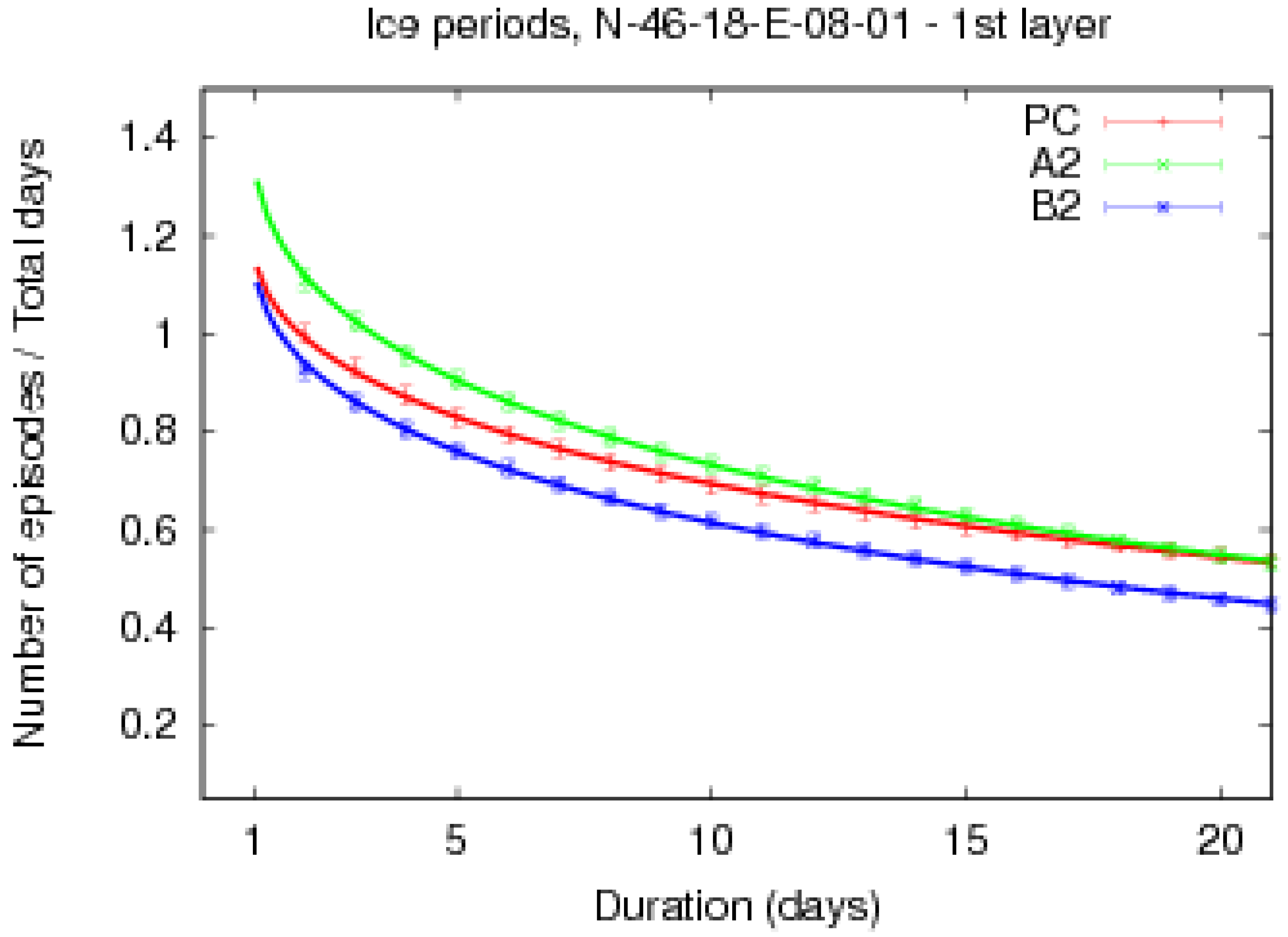
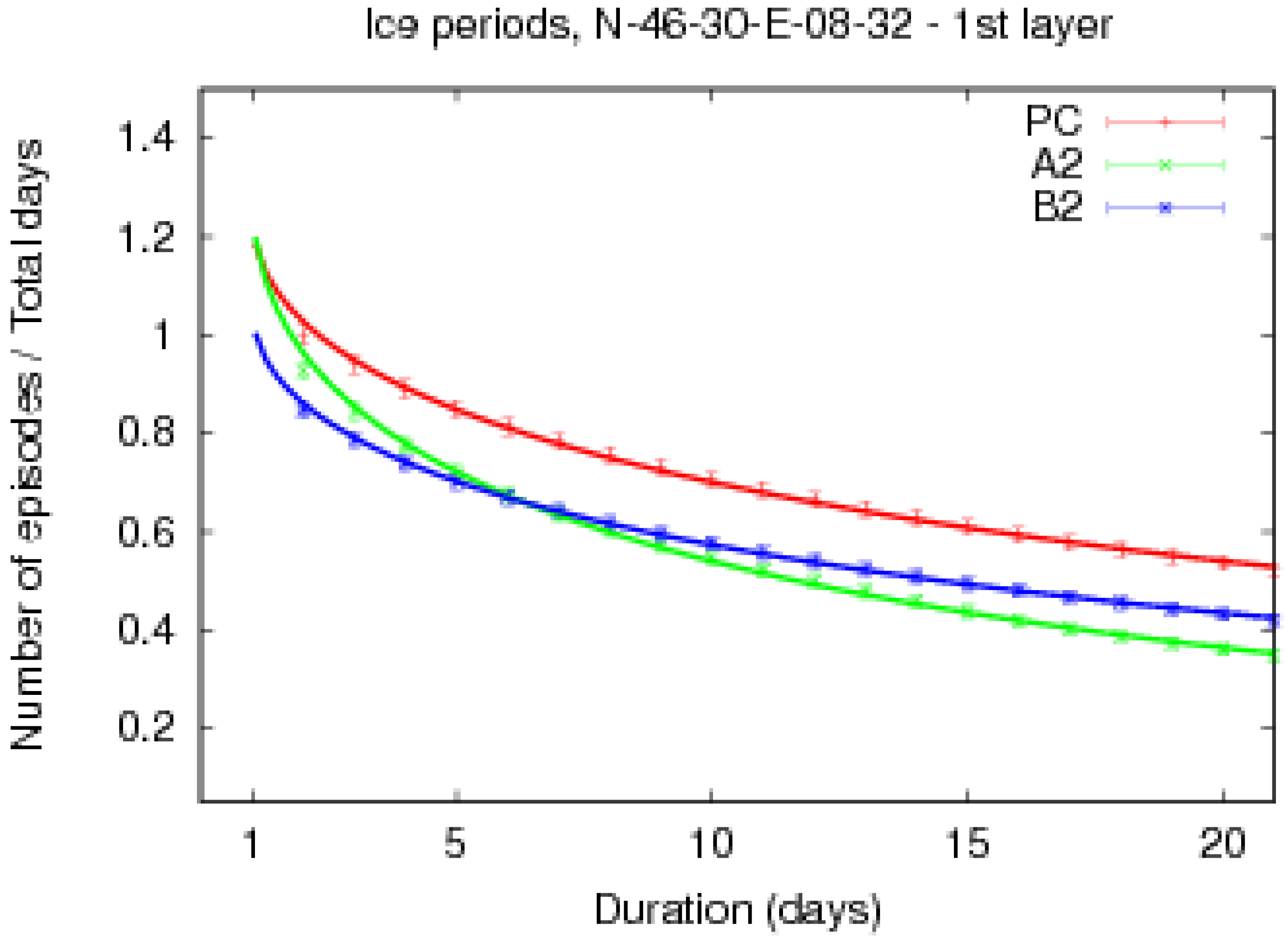
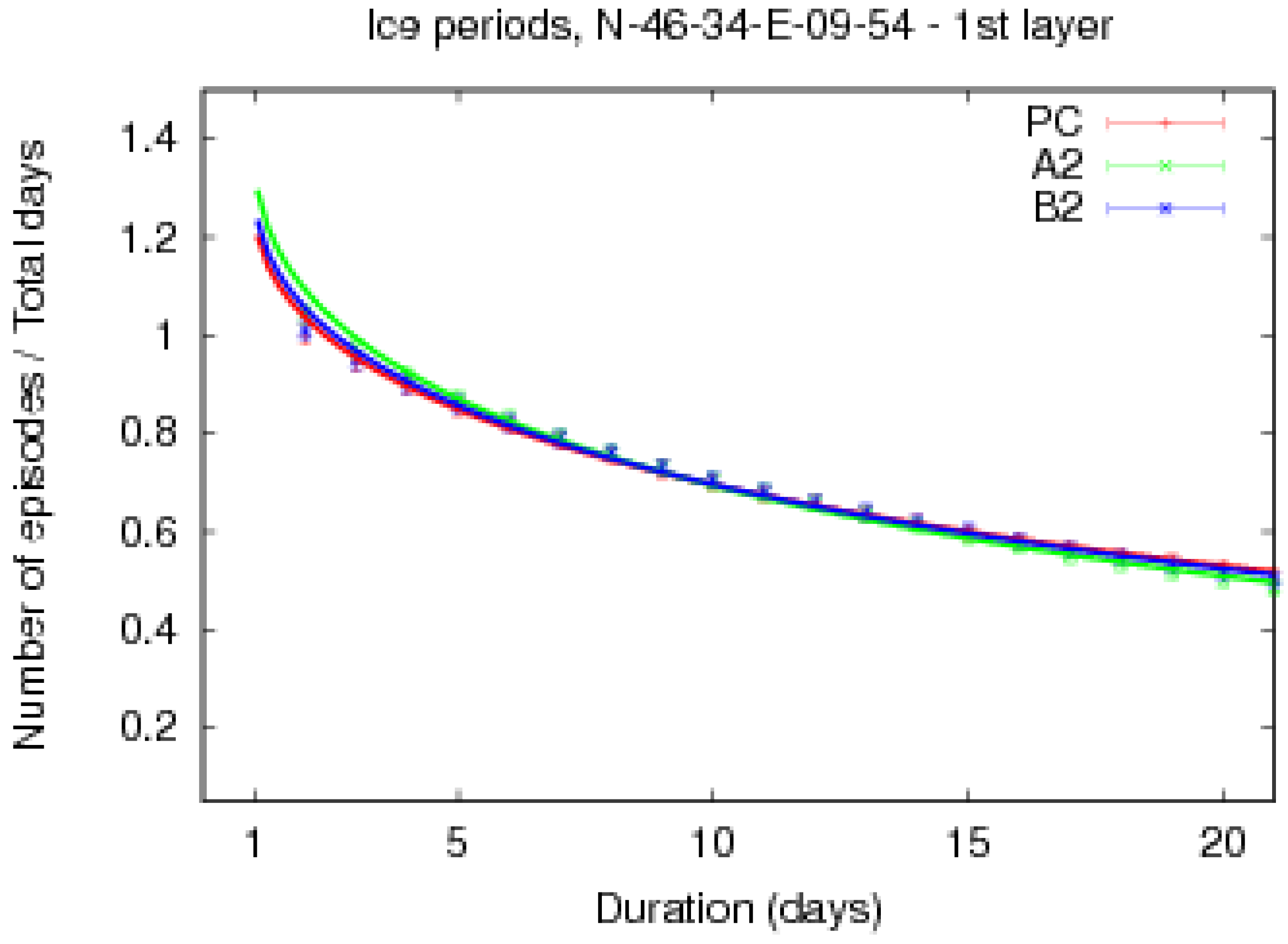
| Category | Example trend figure | Description |
|---|---|---|
| Red | 1 | Number of cold breaks decreasing in FC |
| Blue | 2 | Number of cold breaks increasing in FC |
| Green | 3 | Number of short breaks greater in A2 than B2, number of long breaks greater in B2 than A2 |
| Violet | 4 | No difference between PC and FC |
| Yellow | (not shown) | No difference between PC and A2 |
| Grey | (not shown) | No difference between PC and B2 |

| Category | Below 2000 m ASL | Above 2000 m ASL |
|---|---|---|
| Red | 68 | 34 |
| Blue | 9 | 10 |
| Green | 6 | 5 |
| Violet | 1 | 2 |
| Yellow | 0 | 4 |
| Grey | 3 | 3 |
4.2. Global Statistics of the Occurrence of Cold Breaks

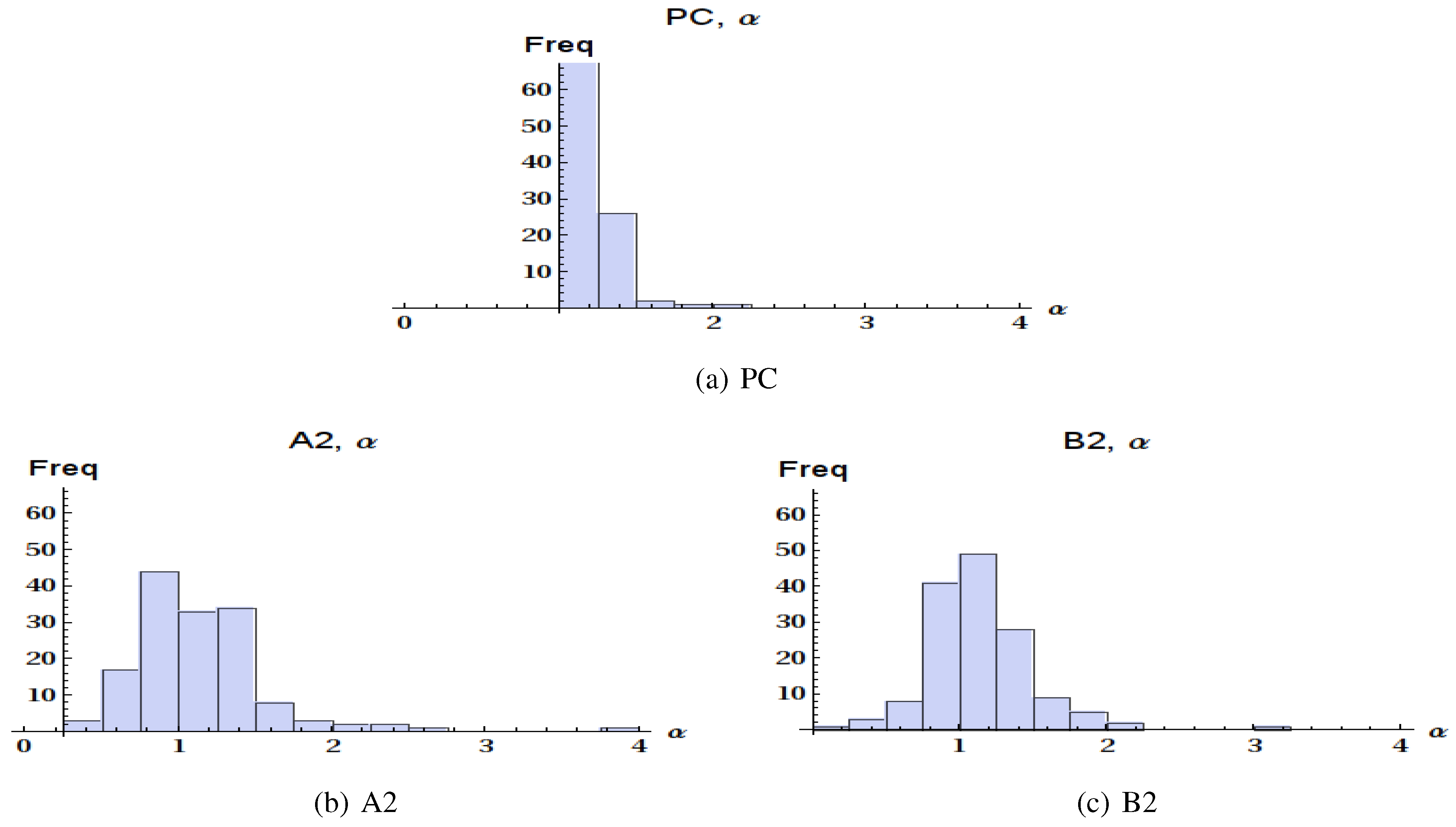
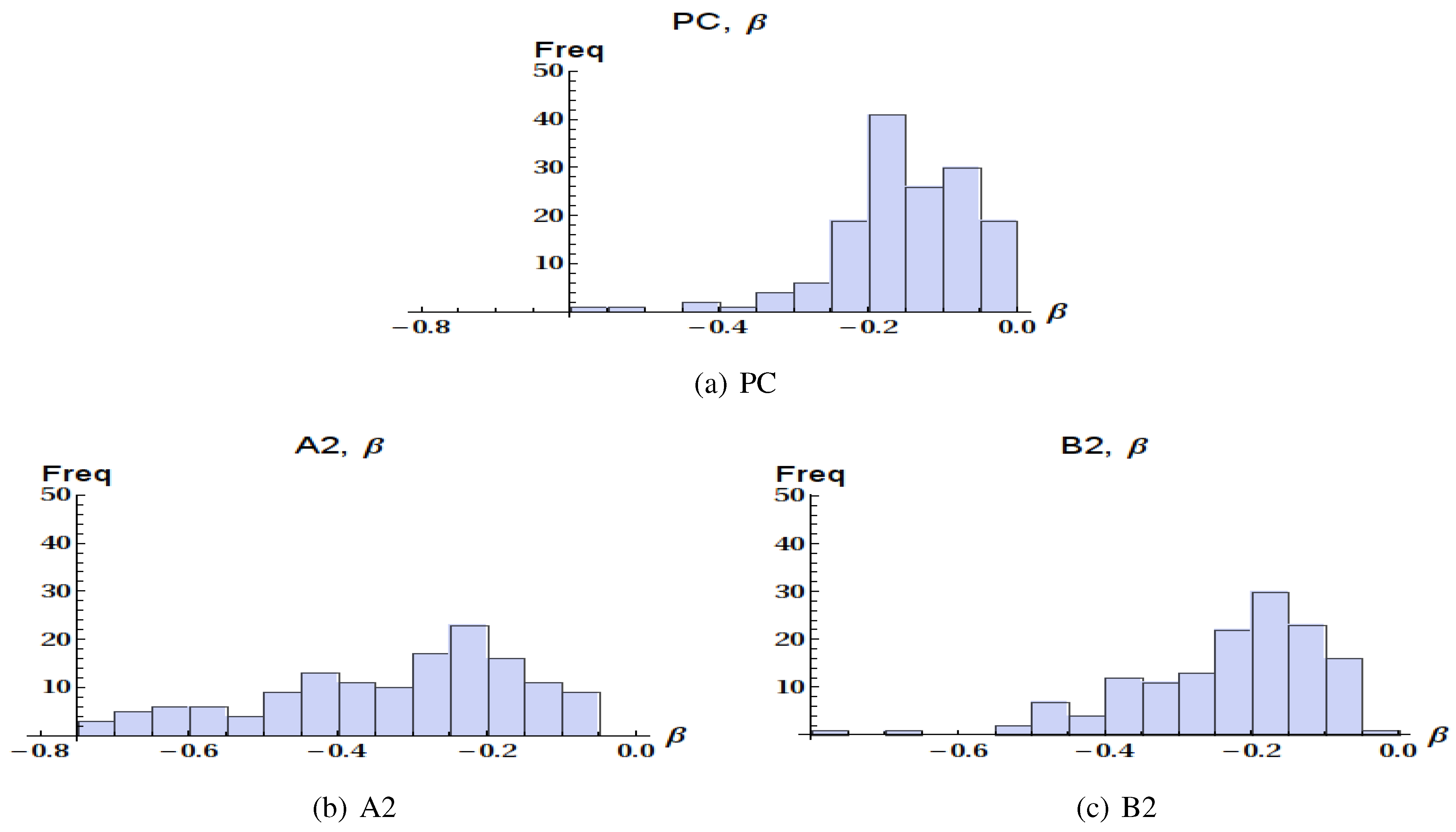
| Pair of scenarios | Distribution | Probability |
|---|---|---|
| α parameter | ||
| PC - A2 | Different | |
| PC - B2 | Different | |
| A2 - B2 | Different | |
| β parameter | ||
| PC - A2 | Different | |
| PC - B2 | Same | |
| A2 - B2 | Different | |
5. Conclusions
Acknowledgements
References
- Stull, R.B. An Introduction to Boundary Layer Meteorology; Springer: Dordrecht, the Netherlands, 1988. [Google Scholar]
- Solomon, S.; Quin, D.; Manning, M.; Chen, Z.; Marquis, M.; Averyt, K.B.; Tignor, M.; Miller, H.L. Climate Change 2007: The Physical Science Basis; Cambridge University Press: Cambridge, UK, 2007. [Google Scholar]
- Shabbar, A.; Bonsal, B. An Assessment of Changes in Winter Cold and Warm Spells over Canada. Natural Hazards 2002, 29, 173–188. [Google Scholar] [CrossRef]
- Nakicenovic, N.; Swart, R. Special Report on Emissions Scenarios: A Special Report of Working Group III of the Intergovernmental Panel on Climate Change; Cambridge University Press: Cambridge, UK, 2001. [Google Scholar]
- Kharin, V.V.; Zwiers, F.W. Changes in the extremes in an ensamble of transient climate simulations with a coupled atmosphere-ocean GCM. J. Clim. 2000, 13, 3760–3788. [Google Scholar] [CrossRef]
- Dickinson, R.E.; Errico, R.M.; Giorgi, F.; Bates, G.T. A regional climate model for the western United States. Climatic Change 1989, 15, 383–442. [Google Scholar] [CrossRef]
- Giorgi, F. Simulation of regional climate using a limited area model nested in a general circulation model. Journal of Climate 1990, 3, 941–963. [Google Scholar] [CrossRef]
- Halenka, T.; Kalvova, J.; Chladova, Z.; Demetrova, A.; Zemankova, K.; Belda, M. On the capability of RegCM to capture extremes in long term regional climate simulation-comparison with the observations for Czech Republic. Theor. Appl. Climatol. 2006, 86, 121–142. [Google Scholar] [CrossRef]
- Im, E.S.; Kwon, W.T. Characteristics of Extreme Climate Sequences over Korea Using a Regional Climate Change Scenario. Sci. Online Lett. Atmos. 2007, 3, 17–20. [Google Scholar]
- Robertson, A.W.; Kirshner, S.; Smyth, P. Downscaling of daily rainfall occurrence over Northeast Brazil using a Hidden Markov model. J. Meteor. Soc. Japan. 2004, 82, 4407–4424. [Google Scholar] [CrossRef]
- Schär, C.; Vidale, P.L.; Lüthi, D.; Frei, C.; Häberli, C.; Liniger, M.; Appenzeller, C. The role of increasing temperature variability in European summer heat waves. Nature 2004, 432, 427–332. [Google Scholar]
- Beniston, M. Mountain weather and climate: A general overview and a focus on climatic change in the Alps. Hydrobiologia 2006, 562, 3–16. [Google Scholar] [CrossRef]
- Regional Climate Change and Adaptation - The Alps Facing the Challenge of Changing Water Resources; European Environment Agency: Copenaghen, Denmark, 2009.
- Beniston, M.; Goyette, S. Changes in variability and persistance of climate in Switzerland: Exploring 20th century observations and 21st century simulations. Global and Planetary Change 2007, 57, 1–15. [Google Scholar] [CrossRef]
- Giorgi, F.; Bi, X.; Pal, J.S. Mean, interannual variability and trends in a regional climate change experiment over Europe. I. Present-day climate (1961–1990). Clim. Dynam. 2004, 23, 839–858. [Google Scholar] [CrossRef]
- Giorgi, F.; Bi, X.; Pal, J.S. Mean, interannual variability and trends in a regional climate change experiment over Europe. II: climate change scenarios (2071–2100). Clim. Dynam. 2004, 23, 839–858. [Google Scholar] [CrossRef]
- Gao, X.J.; Pal, J.S.; Giorgi, F. Projected changes in mean and extreme precipitation over the Mediterranean region from a high resolution double nested RCM simulation. Geophys. Res. Lett. 2006, 33, 1–4. [Google Scholar] [CrossRef]
- Grell, G.A.; Dudhia, J.; Stauffer, D. A description of the Fifth-Generation Penn State/NCAR Mesoscale Model (MM5); NCAR: Boulder, CO, USA, 1994. [Google Scholar]
- Pal, J.; Small, E.; Eltahir, E. Simulation of regional-scale water and energy budgets: representation of subgrid cloud and precipitation processes within RegCM. J. Geophys. Res. 2000, 105, 29579–29594. [Google Scholar] [CrossRef]
- Anthes, R. A cumulus parametrization scheme utilizing a one-dimensional cloud model. Mon. Wea. Rev. 1977, 105, 270–286. [Google Scholar] [CrossRef]
- Giorgi, F. Sensitivity of simulated summertime precipitation over the western United States to different physics parametrization. Mon. Wea. Rev. 1991, 119, 2870–2888. [Google Scholar] [CrossRef]
- Emanuel, K.A. A scheme for representing cumulus convection in large-scale models. J. Atmos. Sci. 1991, 48, 2313–2329. [Google Scholar] [CrossRef]
- Grell, G. Prognostic evaluation of assumptions used by cumulus parametrizations. Mon. Wea. Rev. 1993, 121, 764,787. [Google Scholar] [CrossRef]
- Emanuel, K.A.; Živković-Rothman, M. Development and evaluation of a convection scheme for use in climate models. J. Atmos. Sci. 1999, 56, 1766–1782. [Google Scholar] [CrossRef]
- Dickinson, R.; Henderson-Sellers, A.; Kennedy, P. Biosphere-Atmosphere Transter Scheme (BATS) Version 1e as Coupled to the NCAR Community Climate Model; NCAR: Boulder, CO, USA, 1993. [Google Scholar]
- Giorgi, F.; Francisco, R.; Pal, J.S. Effects of a subgrid-scale topography and land use scheme on the simulation of surface climate and hydrology. Part I : Effects of temperature and water vapour disaggregation. J. Hydrometeor. 2003, 4, 317–333. [Google Scholar] [CrossRef]
- Elguindi, N.; Bi, X.; Giorgi, F.; Nagarajan, B.; Pal, J.; Solmon, F.; Rauscher, S.; Zakey, A. RegCM version 3.1 User’s Guide; ICTP: Trieste, Italy, 2007. [Google Scholar]
- Giorgi, F.; Bates, G.T.; Nieman, S.J. The multi-year surface climatology of a regional atmospheric model over the western United States. J. Clim. 1993, 6, 75–95. [Google Scholar] [CrossRef]
- Giorgi, F.; Shields, C. Tests of precipitation parametrizations available in latest version of NCAR regional climate model (RegCM) over continental United States. J. Geophys. Res. 1999, 104, 6353–6375. [Google Scholar] [CrossRef]
- Diffenbaugh, N.S.; Pal, J.S.; Trapp, R.J.; Giorgi, F. Fine-scale processes regulate the response of extreme events to global climate change. PNAS 2005, 102, 15774–15778. [Google Scholar] [CrossRef] [PubMed]
- Solomon, F.; Giorgi, F.; Liousse, C. Aerosol modelling for regional climate studies: application to anthropogenic particles and evaluation over a European/African domain. Tellus B 2006, 58, 51–72. [Google Scholar] [CrossRef]
- Pal, J.S.; Elthair, A.B. Teleconnections of soil moisture and rainfall during the 1993 Midwest summer flood. Geophys. Res. Lett. 2002, 29, 1865. [Google Scholar] [CrossRef]
- Pal, J.S.; Giorgi, F.; Bi, X. Consistency of recent European summer precipitation trends and extremes with future regional climate projections. Geophys. Res. Lett. 2004, 31, L13202. [Google Scholar] [CrossRef]
- White, M.; Diffenbaugh, N.; Jones, G.; Pal, J.S.; Giorgi, F. Increased heat stress in the 21st century reduces and shifts premium wine production in the United States. PNAS 2006, 103, 11271–11222. [Google Scholar] [CrossRef] [PubMed]
- Abiodun, B.J.; Pal, J.S.; Afiesimama, E.A.; Gutowski, W.J.; Adedoyin, A. Simulation of West African Monsoon using RegCM3. Part II: Impact of desertification and deforestation. Theor. Appl. Climatol. 2007, 93, 245–261. [Google Scholar] [CrossRef]
- Pal, J.S.; Elthair, A.B. A feedback mechanism between soil moisture distribution and storm tracks. Quart. J. Roy. Meteor. Soc. 2003, 129, 2279–2297. [Google Scholar] [CrossRef]
- Cassardo, C.; Ji, J.J.; Longhetto, A. A study of the performances of a Land Surface Process Model (LSPM). Bound. Layer Meteor. 1995, 72(1-2), 87–121. [Google Scholar] [CrossRef]
- Cassardo, C. The Land Surface Process Model (LSPM) Version 2006; Dipartimento di Fisica Generale Amedeo Avogadro: Torino, Italy, 2006. [Google Scholar]
- Ruti, P.M.; Cassardo, C.; Cacciamani, C.; Paccagnella, T.; Longhetto, A.; Bargagli, A. Intercomparison between BATS and LSPM surface schemes, using point mocrometeorological data set. Contrib. Atmos. Phys. 1997, 70, 201–220. [Google Scholar]
- Cassardo, C.; Carena, E.; Longhetto, A. Validation and sensitivity tests on improved parametrizations of a Land Surface Process Model (LSPM) in the Po Valley. Il Nuovo Cimento 1998, 21, 189–213. [Google Scholar]
- Cassardo, C.; Loglisci, N.; Romani, M. Preliminary results of an attempt to provide soil moisture datasets in order to verify numerical weather prediction models. Il Nuovo Cimento 2005, 28, 159–171. [Google Scholar]
- Cassardo, C.; Loglisci, N.; Gandini, D.; Qian, M.W.; Niu, Y.P.; Ramieri, P.; Pelosini, R.; Longhetto, A. The flood of November 1994 in Piedmont, Italy: a quantitative simulation. Hydrol. Process. 2002, 16, 1275–1299. [Google Scholar] [CrossRef]
- Cassardo, C.; Loglisci, N.; Paesano, G.; Rabuffetti, D.; Qian, M.W. The hydrological balance of the October 2000 flood in Piedmont, Italy: quantitative analysis and simulation. Physical Geography 2006, 27, 411–434. [Google Scholar] [CrossRef]
- Cassardo, C.; Mercalli, L.; Cat Berro, D. Charateristics of the summer 2003 heat wave in Piedmont, Italy, and its effects on water resources. J. Korean Meteorol. Soc. 2007, 43, 195–1221. [Google Scholar]
- Feng, J.; Liu, X.; Cassardo, C.; Longhetto, A. A model of plant transpiration and stomatal regulation under the condition of waterstress. J. Desert Res. 1997, 17, 59–66. [Google Scholar]
- Loglisci, N.; Qian, M.W.; Cassardo, C.; Longhetto, A.; Giraud, C. Energy and water balance at soil-air interface in a Sahelian region. Adv. Atmos. Sci. 2001, 18, 897–909. [Google Scholar]
- Cassardo, C.; Park, S.K.; Thakuri, B.M.; Priolo, D.; Zhang, Y. Soil Surface Energy and Water Budgets during a Monsoon Season in Korea. J. Hydrometeor. 2009, 10, 1379–1396. [Google Scholar] [CrossRef]
- Zhang, Y.; Cassardo, C.; Ye, C.; Galli, M. A Landfall Typhoon Simulation in a Coupled Land Surface Process Model Wirh WRF. Asia-Pacific J. Atmos. Sci. 2010, in press. [Google Scholar]
- Burden, R.L.; Faires, J.D. Numerical Analysis; Brooks Cole: Pacific Grove, CA, USA, 2004. [Google Scholar]
- Masson, V.; Champeaux, J.L.; Chauvin, F.; Meriguet, C.; Lacaze, R. A global database of land surface parameters at 1 km resolution in meteorological and climate models. J. Clim. 2003, 16, 1261–1282. [Google Scholar] [CrossRef]
- Bonanno, R.; Loglisci, N.; Cavalletto, S.; Cassardo, C. Soil freezing in LSPM SVAT scheme. Water 2010. submitted. [Google Scholar]
- Wilks, D.S. Statistical Methods in Atmospheric Sciences; Academic Press: Oxford, UK, 1995. [Google Scholar]
- Wald, A.; Wolfowitz, J. On a test wether two samples are from the same population. Ann. Math Statist. 1940, 11, 147–162. [Google Scholar] [CrossRef]
© 2010 by the authors; licensee MDPI, Basel, Switzerland. This article is an Open Access article distributed under the terms and conditions of the Creative Commons Attribution license http://creativecommons.org/licenses/by/3.0/.
Share and Cite
Galli, M.; Oh, S.; Cassardo, C.; Park, S.K. The Occurrence of Cold Spells in the Alps Related to ClimateChange. Water 2010, 2, 363-380. https://doi.org/10.3390/w2030363
Galli M, Oh S, Cassardo C, Park SK. The Occurrence of Cold Spells in the Alps Related to ClimateChange. Water. 2010; 2(3):363-380. https://doi.org/10.3390/w2030363
Chicago/Turabian StyleGalli, Marco, Seungmin Oh, Claudio Cassardo, and Seon Ki Park. 2010. "The Occurrence of Cold Spells in the Alps Related to ClimateChange" Water 2, no. 3: 363-380. https://doi.org/10.3390/w2030363
APA StyleGalli, M., Oh, S., Cassardo, C., & Park, S. K. (2010). The Occurrence of Cold Spells in the Alps Related to ClimateChange. Water, 2(3), 363-380. https://doi.org/10.3390/w2030363




